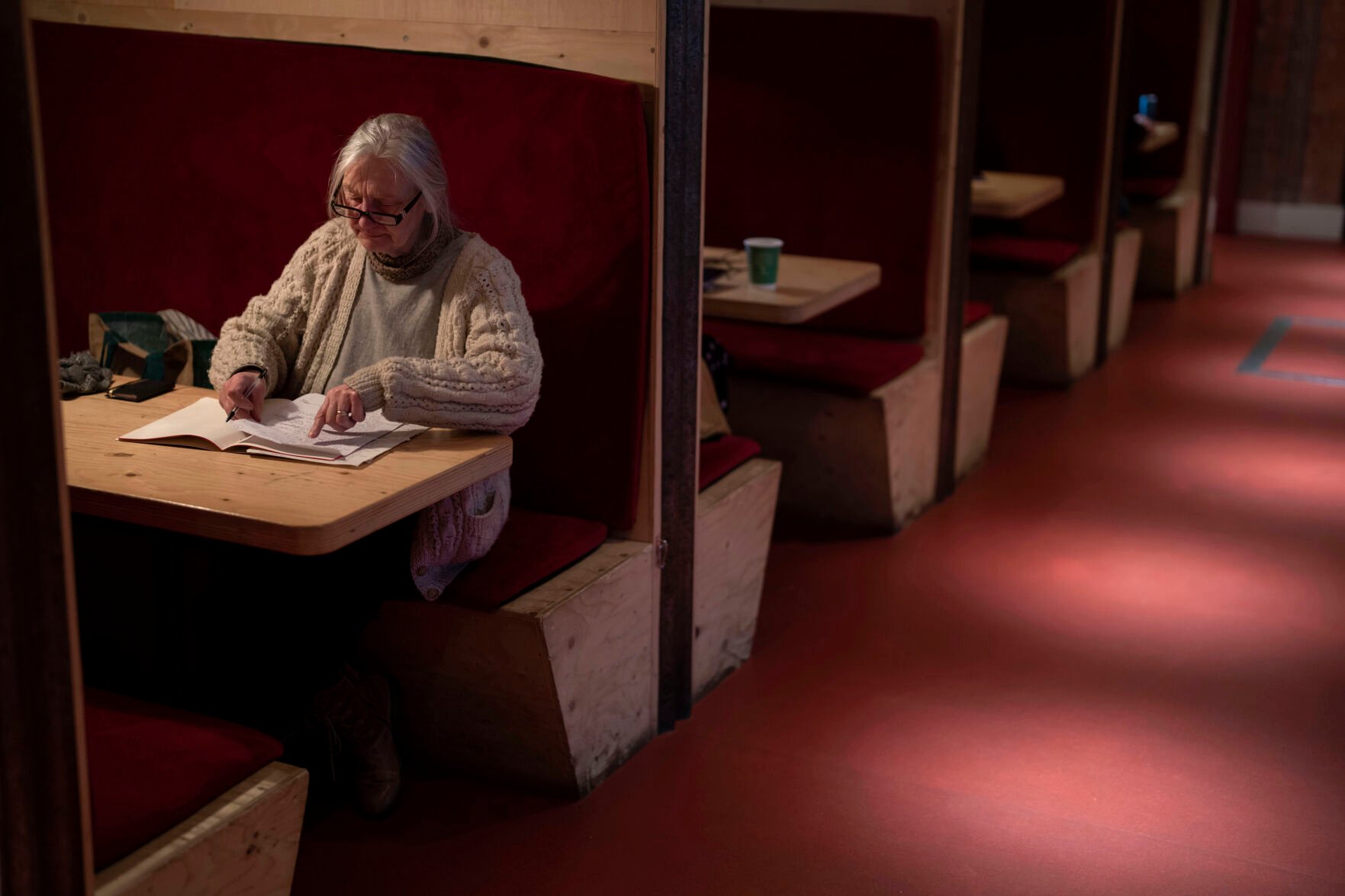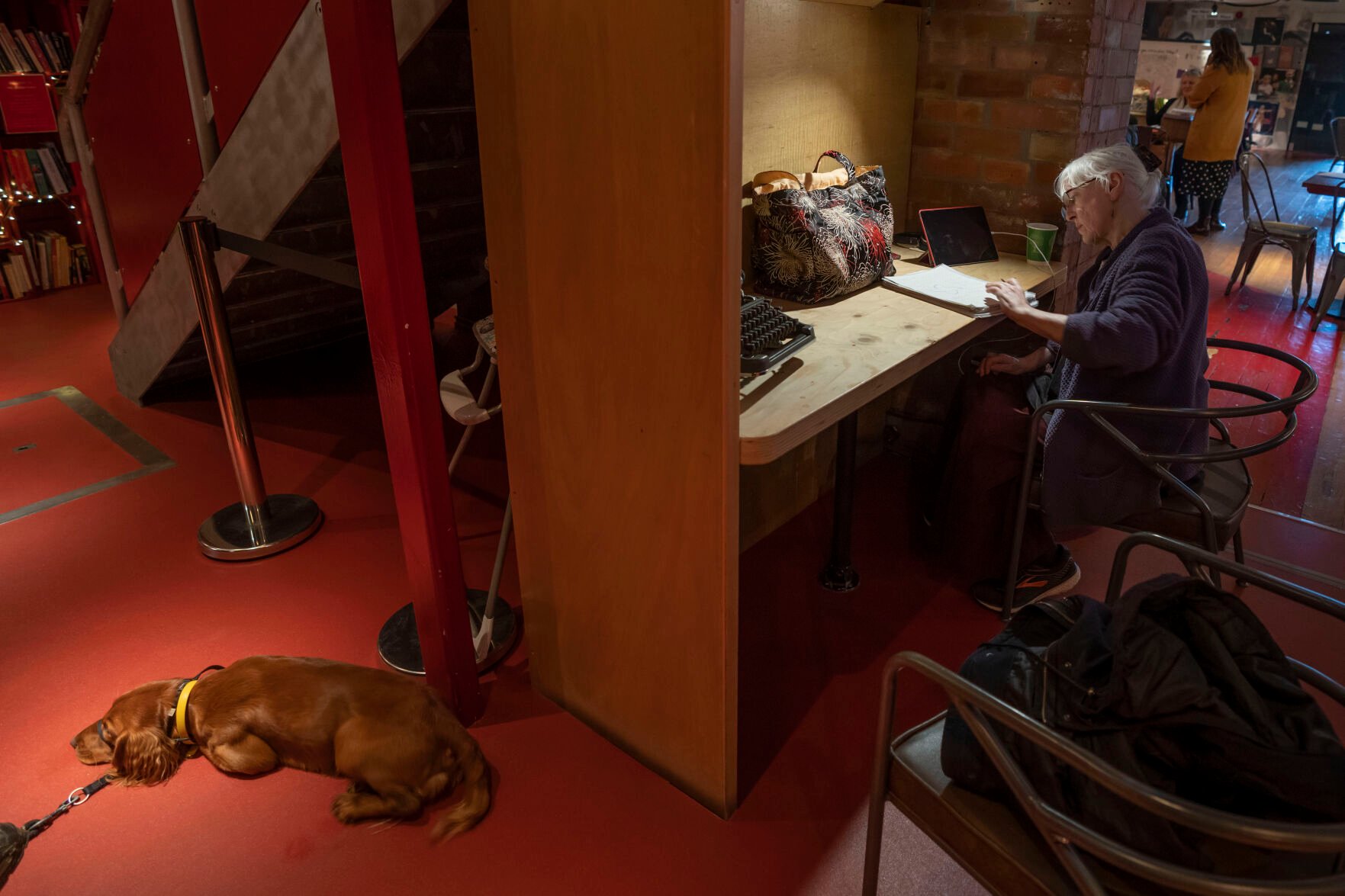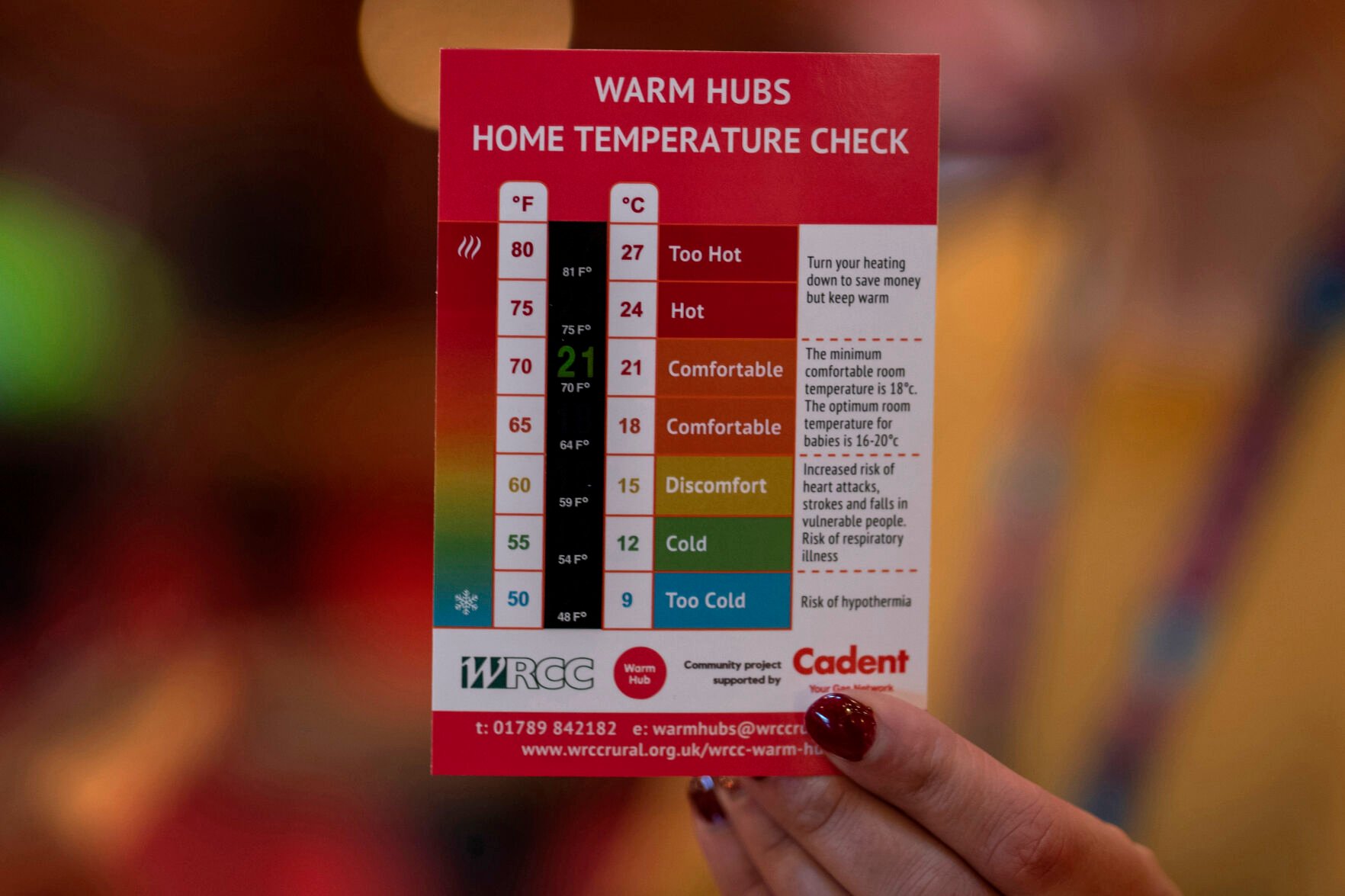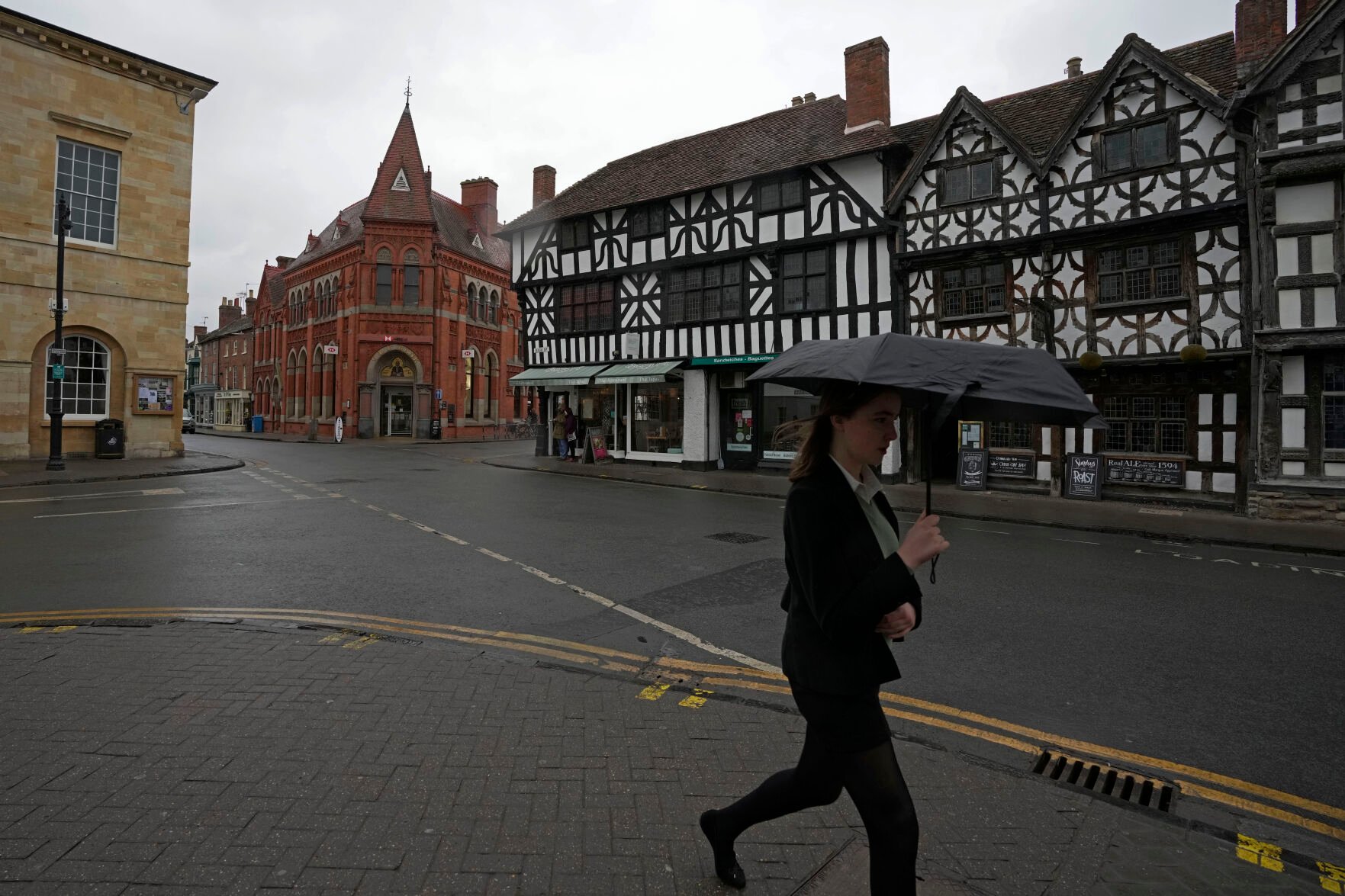STRATFORD-UPON-AVON, England — On a blustery late-winter day in Shakespeare’s birthplace, the foyer of the Other Place theater is a cozy refuge. Visitors are having meetings over coffee, checking emails, writing poetry, learning to sew.
It looks and feels like an arty café on the pictureque streets of Stratford-upon-Avon, but it’s a “warm hub” set up by the Royal Shakespeare Company drama troupe to welcome people struggling to heat their homes because of sky-high energy prices.

Kin Cheung, Associated Press
Wendy Freeman, an artist, writes poem at the Other Place theater, Feb. 28 in Stratford-upon-Avon, Warwickshire, England. The foyer of the Other Place theater in Shakespeare's birthplace of Stratford-upon-Avon is a cozy refuge from winter.
Warm hubs have sprouted across Britain by the thousands this winter as soaring food and energy prices drive millions to turn down the thermostat or skimp on hot meals. Research by the opposition Labour Party counted almost 13,000 such hubs, funded by a mix of charities, community groups and the government and nestled in libraries, churches, community centers and even a tearoom at King Charles III’s Highgrove country estate.
Wendy Freeman, an artist, writer and seventh-generation Stratfordian, heard about the RSC’s warm hub from a friend. She lives in “a tiny house with no central heating” and relies on a coal fire for warmth. Like many, she has cut back in response to the cost-of-living crisis driven by the highest inflation since the 1980s.

Kin Cheung, Associated Press
Anne Bolger works at the Other Place theater, Feb. 28 in Stratford-upon-Avon, Warwickshire, England.

Kin Cheung, Associated Press
A staff member of the Warwickshire Rural Community Council holds a leaflet of temperature checks, Feb. 28 at the Other Place theater in Stratford-upon-Avon, Warwickshire, England. The foyer of the theater now acts a "warm hub," set up by the Royal Shakespeare Company to welcome people who may be struggling to heat their homes because of sky-high energy prices.
“You just adapt,” said Freeman, 69, who was using the center as a warm, quiet place to work on a poem. “Little things, like putting less water in the kettle. I was brought up with ‘save the pennies, and the pounds will look after themselves.’ I always cook from scratch and eat what’s in season.
“But it’s nice to go somewhere warm,” she added.
A perfect storm of Russia’s war in Ukraine, lingering pandemic disruption and economic aftershocks of Brexit is putting more people in Britain under financial strain. Households and businesses were hit especially hard after Russia’s invasion of Ukraine drove up the cost of natural gas needed for heating and helped push the U.K. to the precipice of a recession.
The U.K.’s annual inflation rate was just above 10% in January, with food prices up almost 17% over the year. Some 62% of adults are using less natural gas or electricity to save money, according to the Office for National Statistics. A quarter of households regularly run out of money for essentials, pollster Survation found.
Though oil and natural gas prices have fallen from last year’s peaks, the average British household energy bill is still double what it was a year ago. Costs for many are due to rise by another 20% on April 1 when a government-set price cap goes up.
Anne Bolger, a retired math teacher, happened across the warm hub during a walk one day and has come back every week since. She drops in to check emails, prep for math tutoring or do a jigsaw puzzle.
“Today’s the day that I’m appreciating it, because home is freezing,” she said.
The hub runs one afternoon a week in the smallest of the RSC’s three theaters. On Tuesday, the space held a mixture of theater staff, actors on the way to rehearsals and visitors looking to get warm. Organizers provide puzzles, games, toys for children, free tea, coffee and Wi-Fi — even a sewing table.
“I like the fact that it’s such a creative space,” said Bolger, 66. “People are having meetings there, they’re talking, they’re working. I just feel a bit more alive than sitting at home, a bit more connected.”
That’s just what organizers want to hear. They say warm hubs exist to ease loneliness as well as energy poverty.
“The warmth is in the welcome as much as a warm building to come to,” said Nicola Salmon, who oversees the hub as the RSC’s creative place-making manager. “There is always somebody here to chat to.”

Kin Cheung, Associated Press
A woman walks along a street Feb. 28 in Stratford-upon-Avon, Warwickshire, England.
Stratford, about 100 miles northwest of London, is a prosperous town that makes a good living from William Shakespeare, its most famous son. Even on a wintry weekday, tourists traipse though streets of half-timbered Tudor buildings to see the house where the Bard was born, visit the schoolroom where he studied and stand over his grave in the medieval Holy Trinity Church.
The RSC is one of Stratford’s main cultural attractions and major employers. Salmon says the warm hub is part of the company’s efforts to get closer to its surrounding community, a town that “is often perceived as affluent and well-off” but contains “areas of great deprivation.”
Like Britain’s food banks — now numbering an estimated 2,500 — warm hubs are a crisis measure showing signs of becoming permanent.
The Warwickshire Rural Community Council, a charity covering the county around Stratford, set up a mobile warm hub — a minibus-turned-pop-up outdoor café — in 2021 as pandemic restrictions plunged many rural residents into isolation.
A year ago, the charity ran five hubs across the county, with backing from Cadent, the private company that distributes much of Britain’s heating gas. As winter hit and energy bills soared, the number mushroomed to 90, providing everything from meals to repair workshops and slow-cooking courses meant to reduce gas use.
About 30 of the hubs will stay open this summer — with a view to becoming permanent — and the mobile hub will be on the road five days a week.
“People say we shouldn’t be in this situation, and we shouldn’t be,” said Jackie Holcroft, the charity’s warm hubs manager. “But we are. And I think one of the most amazing things is that you’ve got hundreds, thousands of volunteers around Warwickshire and they’re all coming together to make a difference.”
The RSC’s warm space will close at the end of March, but the company is already planning for its return next year.
“I’ll miss it like crazy,” said Bolger, one of the regulars. “I’m not hoping that the fuel crisis goes on forever, but I am hoping this place will stay open.”
-
EPA outlines $27B ‘green bank’ for clean energy projects
Phuttharak // Shutterstock
A problem the size of climate change requires a solution equally vast in scale. One of the most important actions an environmentally conscious individual can take is to vote and influence elected officials to pass legislation to combat greenhouse gas emissions.
But one should not underestimate the effect one individual can have daily. Thanks in large part to the "knock-on" effect, in the case of sustainability, an individual's actions hardly ever stay in a vacuum. There are many ways a single household can be more environmentally friendly; moreover, evidence shows that neighbors will likely take notice and follow suit in many places.
Between the kitchen and bathroom, the average American uses 156 gallons of water per day. Additionally, many homes are not optimized for insulation, unwittingly using excess energy on heating and cooling.
There are many ways that homeowners can make changes—or mindfully construct when building anew—in their homes to conserve resources, and the Energy Basics Training Tool can be a useful starting point. Even those who rent can still take sustainable steps. For instance, rather than replacing windows with double-glazed glass, renters can add clear sheeting to windows during the wintertime.
Making such upgrades to your home doesn't just help the environment; it can also save a household a significant amount of cash in the long run by cutting down on energy and water expenses. A more sustainable home can also claim a higher selling price when it's time to put it on the market.
Enviro Friendly identified ways to upgrade your home to save money by compiling info from the Department of Energy's Office of Energy Efficiency and Renewable Energy.

Phuttharak // Shutterstock
A problem the size of climate change requires a solution equally vast in scale. One of the most important actions an environmentally conscious individual can take is to vote and influence elected officials to pass legislation to combat greenhouse gas emissions.
But one should not underestimate the effect one individual can have daily. Thanks in large part to the "knock-on" effect, in the case of sustainability, an individual's actions hardly ever stay in a vacuum. There are many ways a single household can be more environmentally friendly; moreover, evidence shows that neighbors will likely take notice and follow suit in many places.
Between the kitchen and bathroom, the average American uses 156 gallons of water per day. Additionally, many homes are not optimized for insulation, unwittingly using excess energy on heating and cooling.
There are many ways that homeowners can make changes—or mindfully construct when building anew—in their homes to conserve resources, and the Energy Basics Training Tool can be a useful starting point. Even those who rent can still take sustainable steps. For instance, rather than replacing windows with double-glazed glass, renters can add clear sheeting to windows during the wintertime.
Making such upgrades to your home doesn't just help the environment; it can also save a household a significant amount of cash in the long run by cutting down on energy and water expenses. A more sustainable home can also claim a higher selling price when it's time to put it on the market.
Enviro Friendly identified ways to upgrade your home to save money by compiling info from the Department of Energy's Office of Energy Efficiency and Renewable Energy.

-
EPA outlines $27B ‘green bank’ for clean energy projects
Enviro Friendly
One of the lowest-lift changes you can make in your household is to replace traditional incandescent light bulbs with energy-efficient ones. These include fluorescent, LED, and halogen bulbs.
Compact fluorescent lights use roughly 75% less energy than incandescent bulbs and can last 10 times longer; LED lights also use 75% less energy and last up to 25 times longer; and halogen bulbs use around 25% less energy and can last about three times longer than traditional bulbs. Many cities and states offer rebates or cost offsets to those switching to energy-efficient lights; search for yours on the Energy Star Rebate Finder.
Enviro Friendly
One of the lowest-lift changes you can make in your household is to replace traditional incandescent light bulbs with energy-efficient ones. These include fluorescent, LED, and halogen bulbs.
Compact fluorescent lights use roughly 75% less energy than incandescent bulbs and can last 10 times longer; LED lights also use 75% less energy and last up to 25 times longer; and halogen bulbs use around 25% less energy and can last about three times longer than traditional bulbs. Many cities and states offer rebates or cost offsets to those switching to energy-efficient lights; search for yours on the Energy Star Rebate Finder.
-
-
EPA outlines $27B ‘green bank’ for clean energy projects
Kathie Nichols // Shutterstock
Wastewater from any source—other than toilets—can be recycled for many nonpotable uses. These include farming, irrigation, construction, and powering factories and mills.
Grey water systems can be installed in private homes for relatively low prices. These systems collect and purify excess water from the washing machine, shower, sinks, and other household sources and reuse it for irrigation on the property. Doing so can cut a household water bill from 30% to 70%.
Kathie Nichols // Shutterstock
Wastewater from any source—other than toilets—can be recycled for many nonpotable uses. These include farming, irrigation, construction, and powering factories and mills.
Grey water systems can be installed in private homes for relatively low prices. These systems collect and purify excess water from the washing machine, shower, sinks, and other household sources and reuse it for irrigation on the property. Doing so can cut a household water bill from 30% to 70%.
-
EPA outlines $27B ‘green bank’ for clean energy projects
New Africa // Shutterstock
Many aren't aware that windows take up 8.6% of energy use in their homes and that poorly installed windows can allow excess cold or heat in, racking up your energy bill.
Homeowners can have the glass double-glazed; ensure frames are properly fitted and insulated; install dynamic facades that adapt to sunlight; and otherwise optimize performance. These actions help windows guard the inside of your home against oppressive sun or cold, which can drain cooling and heating systems from season to season.
However, before upgrading your windows, reference the National Fenestration Rating Council's guide, as the right selection can vary depending on the materials, layout, and environment in and around your home. Besides reducing personal energy bills, by improving the performance of windows on a widespread scale, U.S. annual energy use overall could decrease by 1.7%, and CO2 emissions could fall by 1.9% in 2050.
New Africa // Shutterstock
Many aren't aware that windows take up 8.6% of energy use in their homes and that poorly installed windows can allow excess cold or heat in, racking up your energy bill.
Homeowners can have the glass double-glazed; ensure frames are properly fitted and insulated; install dynamic facades that adapt to sunlight; and otherwise optimize performance. These actions help windows guard the inside of your home against oppressive sun or cold, which can drain cooling and heating systems from season to season.
However, before upgrading your windows, reference the National Fenestration Rating Council's guide, as the right selection can vary depending on the materials, layout, and environment in and around your home. Besides reducing personal energy bills, by improving the performance of windows on a widespread scale, U.S. annual energy use overall could decrease by 1.7%, and CO2 emissions could fall by 1.9% in 2050.
-
-
EPA outlines $27B ‘green bank’ for clean energy projects
monte_a // Shutterstock
Low-flow faucets can reduce the water used and the energy required to heat water. Though removing your old faucets and fitting in new ones may be a hassle, doing so can save 700 gallons—or 40 showers' worth—of water annually.
Some faucets may already qualify as low-flow; accessories that screw onto your current faucet can measure the flow rate. For those that exceed maximum levels, low-flow models can be purchased at a local hardware store and installed independently or with the help of a plumber. In a growing number of states, particularly those that experience frequent droughts, low-flow faucets are becoming mandated, and traditional models are no longer available on the market.
monte_a // Shutterstock
Low-flow faucets can reduce the water used and the energy required to heat water. Though removing your old faucets and fitting in new ones may be a hassle, doing so can save 700 gallons—or 40 showers' worth—of water annually.
Some faucets may already qualify as low-flow; accessories that screw onto your current faucet can measure the flow rate. For those that exceed maximum levels, low-flow models can be purchased at a local hardware store and installed independently or with the help of a plumber. In a growing number of states, particularly those that experience frequent droughts, low-flow faucets are becoming mandated, and traditional models are no longer available on the market.
-
EPA outlines $27B ‘green bank’ for clean energy projects
Juice Verve // Shutterstock
Particularly if you have an older home, your home probably needs to be optimized for energy efficiency. Installing new insulation may cost money in the short term, but it can save an average of 15% annually on heating and cooling bills.
The first step in insulating your home is conducting or hiring a professional for an energy audit to identify areas with no or low R-value (which measures the thickness and depth of insulation).
The Department of Energy's Home Energy Saver can help you plan how much insulation will cost in your situation and what rate of return to expect. Some homeowners may be eligible for tax incentives to fund part of the installation cost.
This story originally appeared on Enviro Friendly and was produced and distributed in partnership with Stacker Studio.
Juice Verve // Shutterstock
Particularly if you have an older home, your home probably needs to be optimized for energy efficiency. Installing new insulation may cost money in the short term, but it can save an average of 15% annually on heating and cooling bills.
The first step in insulating your home is conducting or hiring a professional for an energy audit to identify areas with no or low R-value (which measures the thickness and depth of insulation).
The Department of Energy's Home Energy Saver can help you plan how much insulation will cost in your situation and what rate of return to expect. Some homeowners may be eligible for tax incentives to fund part of the installation cost.
This story originally appeared on Enviro Friendly and was produced and distributed in partnership with Stacker Studio.




